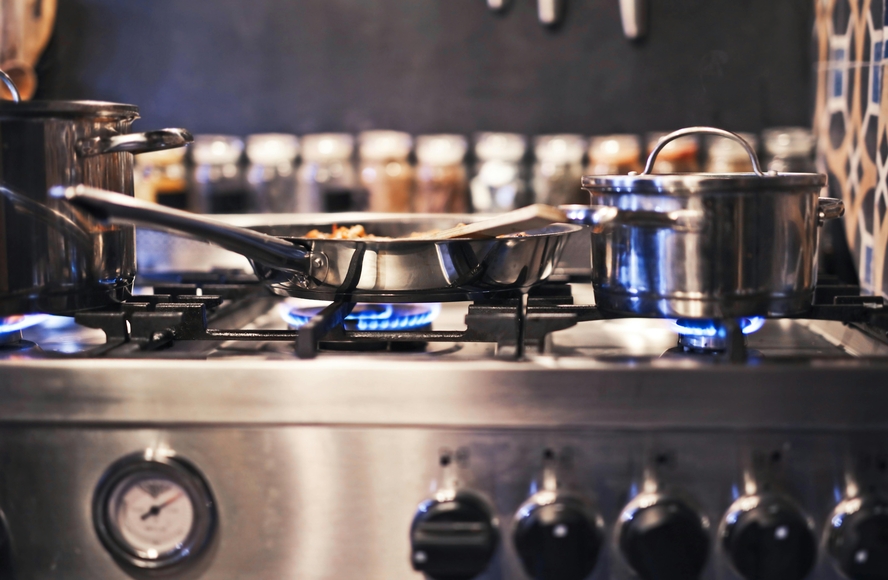
Gone are the days of choosing cookware based purely on performance. Why? Because now we know that traditional nonstick cookware is full of toxic per- and polyfluoroalkyl substances (PFAS), known affectionately (or not so affectionately) as “forever chemicals.” As you navigate the ever-changing research about the best kitchenware for our health, we’re here to answer the question: Is stainless steel cookware safe?
When choosing cookware in this day and age, we shouldn’t have to sacrifice performance to get safe, non-toxic options. Thankfully, we no longer have to (phew). These days, there is no shortage of amazing safe cookware options — we’ve even narrowed it down to the 7 Best Non-Toxic Cookware Options of 2024 if you’re on the market for new pots and pans.
Among the many popular clean cookware options is stainless steel. It is generally considered one of the safest materials available, thanks to its non-toxic qualities. But what else do you need to know if you’re considering investing in stainless steel cookware? Let’s dig into the pros, the cons, and the opinion of professional chef Aran Goldstein (whose experience in Michelin-starred kitchens around the world makes him more than qualified to weigh in!) to find out.
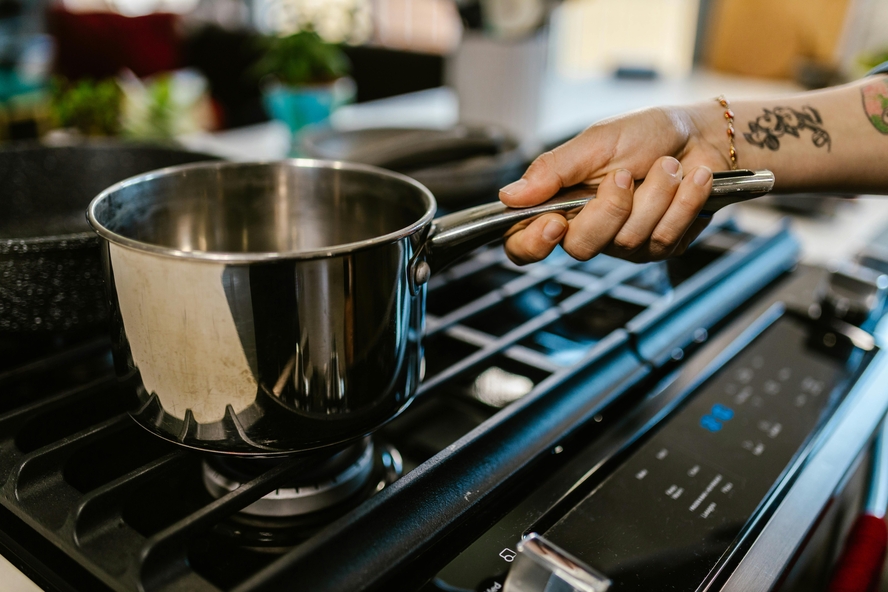
What Are Forever Chemicals?
First and foremost, stainless steel is a great option for cookware because it’s free of PFAS chemicals. What does that mean? Well, conventional nonstick cookware (like Teflon) relies on a chemical nonstick coating that makes for an arguably sleek cooking experience. The perfect eggs every time, the perfect pancakes that don’t stick to the pan. It’s a beautiful thing, but at what price? Unfortunately, your health. And if this is all new to you, check out our deep dive on PFAS to understand how these chemicals came about.
These toxic substances have been shown to leech from pots and pans into your food, which then enters your body and builds up in your blood and organs.1 If that weren’t horrifying enough, a build-up of these toxins in your body has been shown to cause various types of cancers, infertility, thyroid issues, and more.
What Makes Stainless Steel Cookware Safe?
Now that we’ve covered our key question (Is stainless steel cookware safe? Short answer: yes!), let’s discuss why stainless steel cookware is safe. Unlike Teflon or aluminum, stainless steel cookware doesn’t contain chemicals like PTFE (polytetrafluoroethylene) or PFOA (perfluorooctanoic acid) that can leach into food. Instead, stainless steel is a metal alloy, typically comprised of a combination of iron, chromium, and nickel. The chromium creates a durable, non-reactive layer, making stainless steel a great non-toxic, inert surface to cook on.
Though stainless steel is among the healthiest pans to cook with (alongside non-toxic nonstick cookware options like ceramic-coated or pure ceramic pots and pans), some studies show evidence that the nickel in the core of this cookware can leach into the food when cooking.1
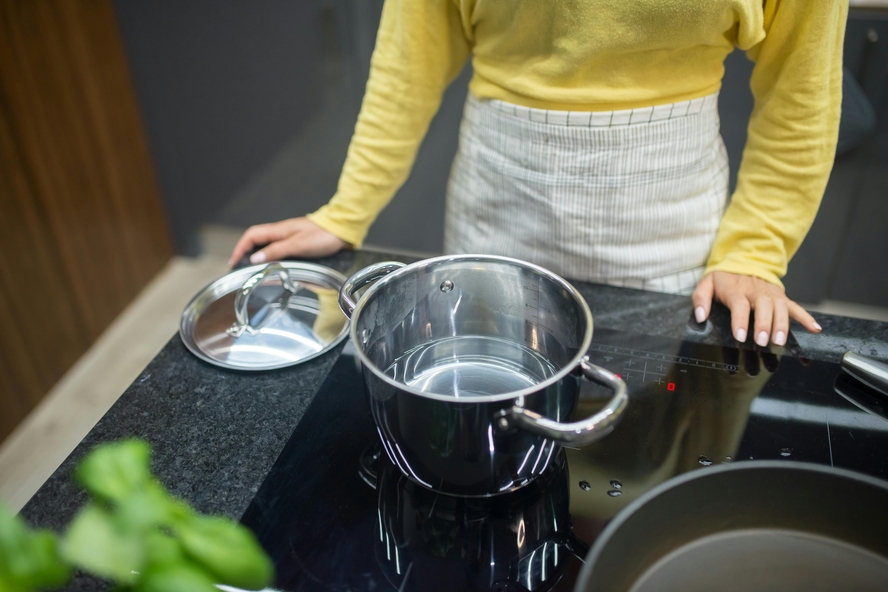
While this may be true, the human body can actually handle up to 1,000 μg of nickel per day.2 The same studies show that only about 88 μg of nickel is leached from stainless steel pots and pans during the cooking process. In fact, another study reports that nickel can be found in most of our food, and is especially prevalent in cacao, soya beans, oatmeal, nuts, seeds, seafood, and legumes.
Essentially, that means that the nickel leached from stainless steel cookware is of minimal concern. With that said, there are still a number of ways to reduce the amount of nickel leached from your stainless steel pots and pans.
How to Reduce Nickel Leaching From Your Stainless Steel Cookware
1. Avoid cooking acidic foods in stainless steel
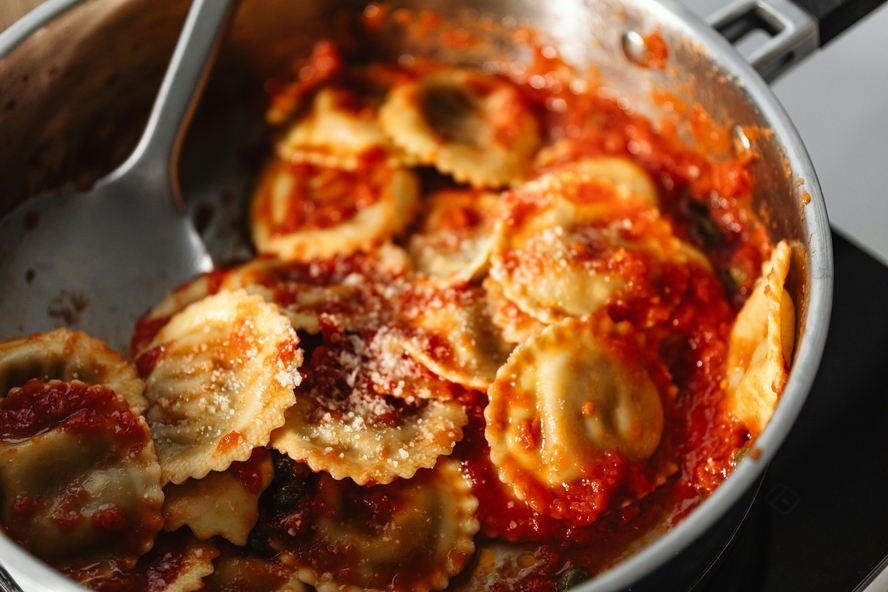
Stainless steel is considered to be non-reactive, which means it’s typically a better choice when cooking anything acidic like lemon or tomatoes. However, one thing to keep in mind is that cooking acidic foods can increase the risk of leaching nickel. To avoid possible leaching, aim to use ceramic-coated or pure ceramic pots and pans for these foods. For a broader overview on the differences between these types of cookware, check out our article Stainless Steel Vs. Ceramic Cookware: Which Is Best for You?.
If you need help choosing the best ceramic options, check out our Chef-Tested Guide to the 6 Best Ceramic Cookware Sets of 2024. Or if it’s bakeware you’re after, you’re in luck: we’ve also put together this ultimate guide to the Best Non-Toxic Bakeware, which includes not just ceramic options, but porcelain and glass options too.
2. Use your cookware
This may seem obvious, because of course you’re going to use the shiny cookware set you’ve just bought. What else would you do with it? Well, now you have even more reason to host your next dinner party — research shows that the more you use your stainless steel cookware, the less the nickel leaches into the food. And if you already make great use of your stainless steel pots and pans, you’re probably safe from leaching!
3. Turn down the heat and switch to 3-ply stainless steel
Heat is a major factor in nickel leaching. In fact, the nickel doesn’t leach until it reaches roughly 400 degrees Fahrenheit. Stainless steel cookware offers a few options when it comes to “ply”: 3-ply, 5-ply, and 7-ply. The numbers indicate the layers of metal in the core. Using 3-ply stainless steel cookware means the pan will heat up more quickly, which means you can cook at lower temperatures (specifically, below the nickel leaching point of 400 degrees F).
Beyond the benefit of avoiding nickel leaching, 3-ply stainless steel pots and pans are also more lightweight than their 5-ply counterparts — not to mention cheaper! The only downside to be aware of is that the thinner nature of 3-ply stainless steel means it’s more susceptible to scratches, dents, and uneven heating.
| Pros | Cons | |
| 3-ply | More affordable | Less durable |
| Lightweight and easy to handle | Easier to scratch and warp | |
| Heats up quickly | More prone to hot spots and uneven heating | |
| 5-ply | More durable and resistant to scratches | More of an upfront investment |
| More even heat distribution and better heat control | Heavier and less easy to maneuver in the kitchen |
The Different Grades of Stainless Steel
As with most things in life, not every stainless steel pan is created equal. While all stainless steel cookware on the market must be food grade, manufacturers produce and sell 200, 300 and 400 series steel for you to choose from. If you’re looking for the best stainless steel pan, understanding the difference between various grades will give you the context to make your decision.
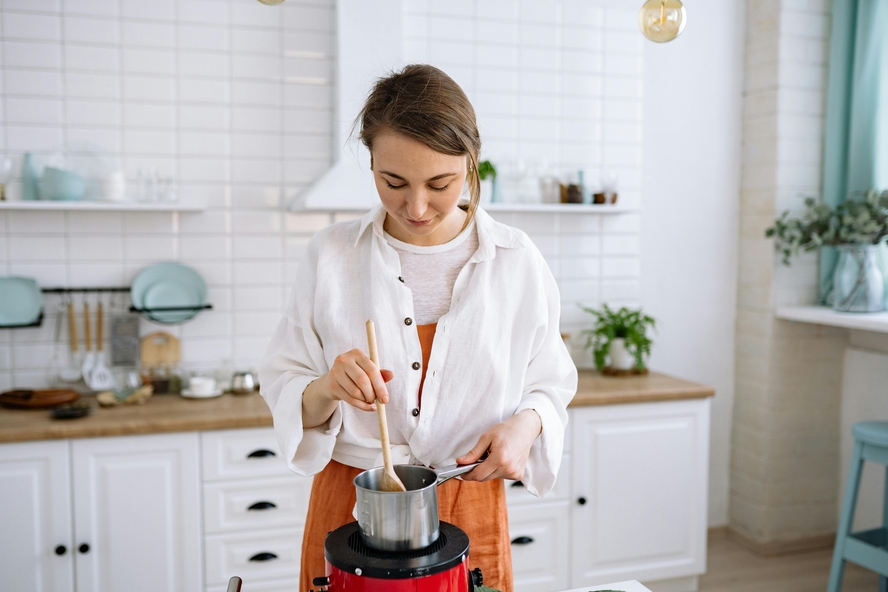
As you may have guessed, 200 series stainless steel is the lowest grade and the cheapest.3 The most common series for cookware, however, is the 300 series — specifically, the 304 and 316 series, which are also known as 18/8 and 18/10, respectively. The 18 refers to the percentage of chromium in the cookware, and the 8 and 10 refer to the percentage of nickel.
| 304 Stainless Steel | 304 is far the most common type of stainless steel used in cookware, and is typically sufficient for home chefs | |
| More cost-effective than 316 stainless steel | ||
| Good corrosion resistance | ||
| 316 Stainless Steel | A high-end stainless steel that offers greater strength and durability | |
| Contains a small percentage of molybdenum (or titanium) and a higher nickel content | ||
| Also known as “surgical stainless steel,” 316 stainless steel is even more resistant to corrosion | ||
| Can hold its shape better than 304 stainless steel | ||
| More expensive | ||
Although there are slight differences between these two stainless steel options, the difference in performance is negligible, and you’re unlikely to be able to tell these materials apart in the kitchen. While 316 is the highest grade in the 300 series, both it and the 304 series are ideal options for anyone looking for the healthiest stainless steel pans to cook with.
Pros and Cons of Stainless Steel Cookware

Overall, stainless steel cookware is a solid choice for a non-toxic cooking experience. But if you’re weighing up a decision between stainless steel and another safe option, it can be helpful to review the advantages and disadvantages of stainless steel:
Pros:
- Non-toxic: Needless to say, one huge pro for stainless steel is that it’s free from the chemicals found in traditional nonstick coatings. When answering the question “Is stainless steel cookware safe?”, knowing that it has no PFAS chemicals is a huge plus.
- Durable: These pans are known for their longevity and resistance to rust. They also do not scratch easily, provided you get a high-quality grade of stainless steel.
- Good heat distribution: Again, provided you invest in a high-quality grade of stainless steel, the core of these pots and pans enables even heating (meaning fewer hot spots and less burnt food!).
- Easy to clean: Stainless steel doesn’t require special care like cast iron, and it’s easy to clean with hot water, soap, and a gentle sponge.
- Versatile: The material is great for a wide range of cooking styles and recipes — you can take it from the stovetop to the oven, use it for braises, simmer sauces over long periods of time, and whip up a quick omelet or batch of pancakes with ease.
Cons:
- Food may stick: Stainless steel isn’t naturally nonstick, so cooking techniques matter. For example, pan-seared salmon may be more challenging in stainless steel. You can still achieve great results, but you have to take the time to remove the moisture from your fish and properly heat up your pan and cooking oil.
- Initial cost: Although its durability makes this cookware affordable in the long run, high-end stainless steel pans can be pricey upfront.
- There is a learning curve: As amazing as stainless steel cookware is, there is a bit of an uphill climb in learning how to use it. But once you know how, it’s a dream, and it’s the preferred cookware of many working chefs.
According to professional chef and teacher, Aran Goldstein, knowing how to use your stainless steel cookware is of the utmost importance. Goldstein explains, “Stainless steel is all about how you use it. You can make an omelet in a stainless steel pan, but if you don’t have enough fat, it will stick.”
Goldstein is a graduate of the New England Culinary Institute and has worked everywhere from fine dining restaurants in the Northeast to Michelin-starred restaurants in Italy — he’s even opened a restaurant in China. He’s passionate about organic farm-to-table cooking for the whole family, and shares many of his stainless steel cookware tips for making nourishing, family-friendly meals in his Food Reset course.
Stainless steel is all about how you use it. You can make an omelet in a stainless steel pan, but if you don’t have enough fat, it will stick.
Aran Goldstein
How to Maintain Stainless Steel Cookware
While stainless steel is low-maintenance, the following tips can help keep it looking and performing its best:
- Use adequate fat: A small amount of oil or butter goes a long way in preventing food from sticking.
- Preheat before cooking: This helps food release more easily from the surface of the pan.
- Avoid harsh cleaners: Mild dish soap and water work fine. For tough spots, you can also try making a paste of baking soda and water to use as a scrub.
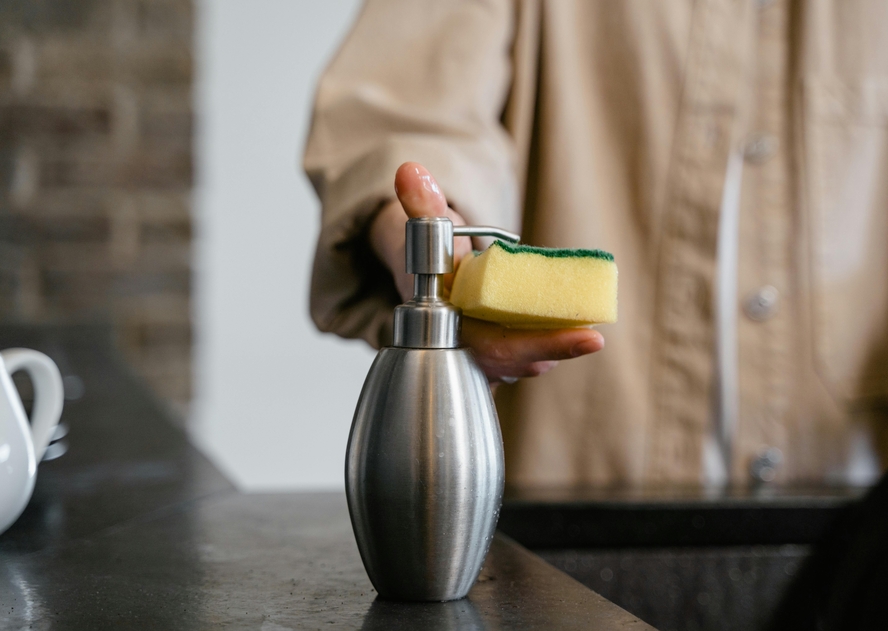
Stainless Steel Cookware FAQs
Is 18/10 stainless steel cookware safe?
Yes, 18/10 stainless steel is safe for cooking. It contains 18% chromium and 10% nickel, which provides strength and rust resistance.
Is 5-ply stainless steel safe?
Absolutely. The multiple layers improve heat conductivity, making 5-ply stainless steel cookware a great choice for consistent cooking.
Is stainless steel non-toxic?
Yes, stainless steel is free from PFOA, PTFE, and other harmful PFAS chemicals. Its non-reactive surface also helps minimize leaching.
Is titanium stainless cookware safe?
Yes. Titanium is a naturally occurring, non-reactive metal — so it doesn’t rust or react to acids. Titanium is used in clad cookware, which means it’s layered with other metals like aluminum and stainless steel, and has similar pros and cons to its stainless steel counterpart.
Is aluminum in cookware safe?
It’s debatable. The general consensus is that aluminum is best used as a core because it’s such a great heat conductor, and cooking directly on aluminum can leach high amounts of aluminum into the food. More recent news has linked the exposure of aluminum with the development of Alzheimer’s4, although there haven’t been enough studies to draw definitive conclusions.5 Notably, however, six European countries have banned the use of aluminum cookware, so we’re doing our best to steer clear.
Is stainless steel cookware dishwasher-safe?
Technically, yes! However, dishwasher-safe cookware doesn’t mean you should get rid of your sponges altogether. Most experts agree that the dishwasher will speed up the wear and tear on your cookware. Whenever possible, it’s best to use hot water, soap, and a gentle sponge. For caked on messes, soak the cookware in hot water and soap. If that fails, you can try Bar Keepers Friend.
Final Thoughts: A Versatile and Safe Choice for Home Cooks
Stainless steel’s durable, non-toxic nature makes it one of the safest cookware options. From pan-seared steaks to delicate sauces, stainless steel can handle a wide range of dishes. So, is stainless steel cookware safe? In short, yes — it’s an amazing all-purpose cookware for home cooks who appreciate clean food, non-toxic products, and a pan that can do it all.
Read More on Organic Authority
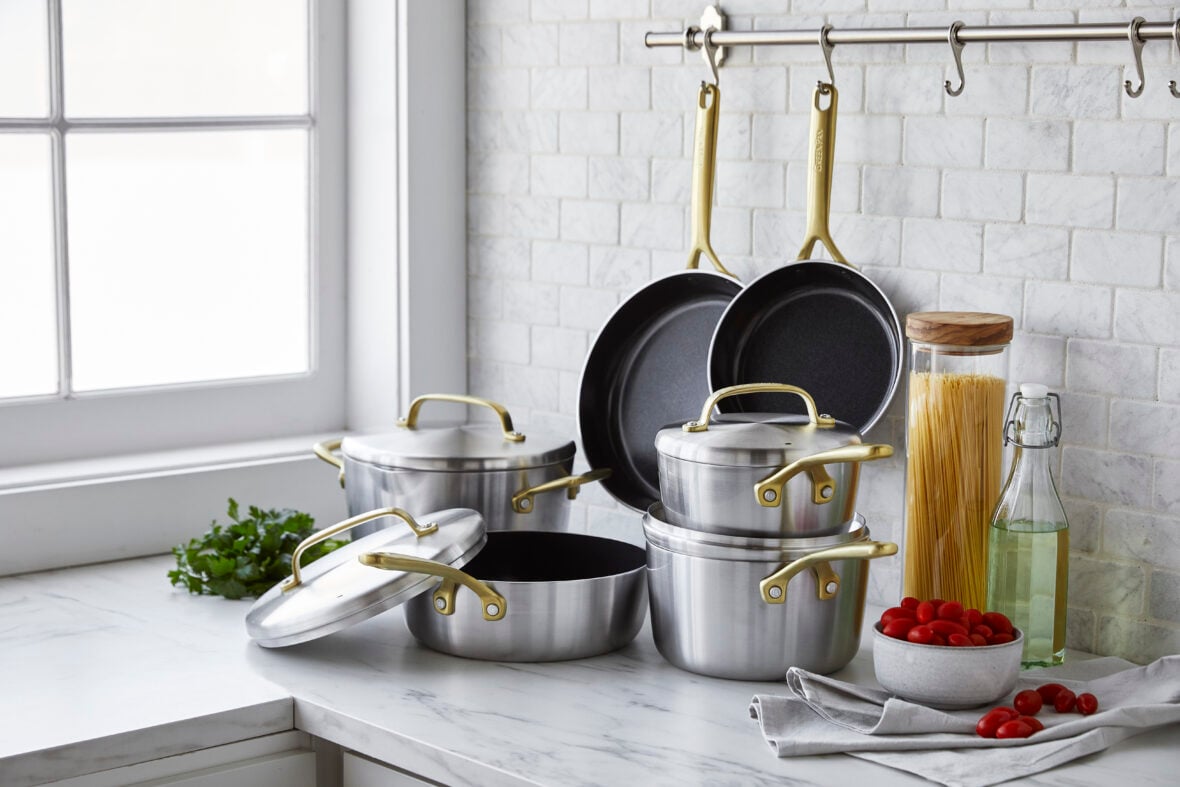
Sources:
- https://www.ewg.org/tapwater/contaminant.php?contamcode=E207
- https://www.ncbi.nlm.nih.gov/pmc/articles/PMC3667300/
- https://www.foodandwine.com/guide-to-stainless-steel-cookware-8558171
- https://www.alzheimers.org.uk/about-dementia/managing-the-risk-of-dementia/possible-risks-of-dementia/metals
- https://www.ncbi.nlm.nih.gov/pmc/articles/PMC6804775/
References:
- Mayo Clinic. “Is Nickel in Stainless Steel Safe?”
- Cook’s Illustrated, “Comparing Multi-Ply Cookware: What You Need to Know.”
- PubMed. “Non-Toxic Properties of Stainless Steel Cookware.”

